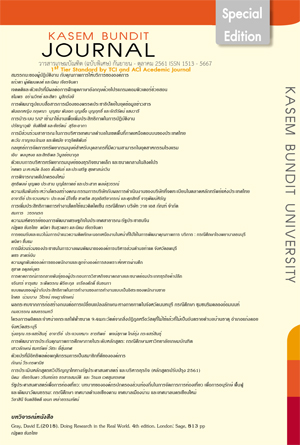The Relationship between Structure of the Board of Directors and the Performance of Companies Listed on the Stock Exchange of Thailand
Keywords:
Structures of the board of directors, Firms Performance, The Listed Companies The Stock ExchangeAbstract
This research studied the structure of the Board of Directors and the the performance of the listed companies in the Stock Exchange of Thailand (SET). The authors conducted a survey of 340 companies listed on SET called SET100 group. The study found that the majority of the Board consisted of 11-15 members, There was a separate role of Chief Executive Director and Chairman of the Executive Board. It was also found that there was Audit Committee, but neither Search Committee nor Remuneration Committee. There was concentrated ownership structure and the high level of the resources and the supportive service roles. Additionally, it was revealed that Board of Directors composition affected performance in the Sub-Committee i.e., the Audit Committee. The role of the Board was concerned with providing resources and the supportive service roles that affected positively operating results significantly. Structure of ownership and the roles of the Board such as policy and strategy setting, monitoring and controlling did not affect operations significantly. Furthermore, it was also demonstrated that firm age had a significant and positive effect on the operating result.
References
Ananya Khunthit, Silpaporn Srijunpetch, and Penchan Chansiri.(2009). Corporate Governance. Bangkok: The Stock Exchange of Thailand.
Ambastha, A. and Momaya, K. (2004). Competitiveness of Firms: Review of Theory,Frameworks and Models. Singapore Management Review, 26(1), 45-61.
Balachandran, J & Bliss, M. (2004). Board independence and voluntary disclosure: Evidence from Malaysia. Working Paper, Department of Accountancy City University of Hong Kong.
----------. (2004, July). Board Independence and Voluntary Disclosures: Evidence from Malaysia. Accounting and Finance Association of Australia and New Zealand (AFAANZ) Conference, Australia: Alice Springs.
Ball, R., A. Robin, & J. S. Wu. (2003). Incentives versus standards : Properties of accounting income in four EastAsian countries. Journal of Accounting and Economics, 36 (1-3), 235-270.
Berle, A.& Means, G. (1968). The modern corporation and private property.New York, NY: Harcourt.
Bonn, I., Yoshikawa, T. & Phan, P. H. (2004).“Effects of Board Structure on Firm Performance : A Comparison Between Japan and Australia” Asian Business & Management, 3, 105-125.
Beasley, M.S. (1996). An empirical analysis of the relation between the board of Director composition and financial statement fraud. The Accounting Review, October, 443-466.
Brennan. (2006). Boards of Directors and Firm Performance: is there an expectations gap?. Corporate Governance. An International Review, 4(6), November 2006, 577–593.
Chow C.W. & Wong-Boren. A. (1987). Voluntary financial disclosure by Mexican Corporations. The Accounting Review. 62(3). 533-541.
C. l. Barnard. (1938). Functions of the Executive. Mass.: Harvard Univ. Press, 19-20.
Cravens, K.S., & Wallace, W. A. (2001). A framework for determining the influence of the corporate board of directors in accounting studies. Corporate Governance 9, 2-24.
Cronbach, Lee Joseph. (1974). Essentials of Psychological Testing. (3rd ed.). New York: Harper and Row.
Davis, J.H., Schoorman, F.D., & Donaldson, L. (1997). Academy of Management Review, 22,20-47.
Daily, C. M., and D. R. Dalton (1993). "Board of Directors Leadership and Structure: Control and Performance Implications," Entrepreneurship: Theory and Practice, 17(3), 65-81.
________. (1994). “Bankruptcy and corporate governance: The impact of board composition and structure” Academy of Management Journal, 37, 1603–1617.
Donatella, Depperu and Daniele, Cerrato. (2005). Analyzing International Competitiveness at the Firm Level: Concepts and Measures. Working Paper No. 32. Retrieved December 6, 2009, from dipartimenti.unicatt.it/ Donaldson dises_wp_azzurra_05_32.pdf.
Donaldson, L., Davis, J. (1991). Stewardship theory or Agency theory: CEO governance and shareholder returns, Australian Journal of Management, 16(l), 49-64.
Eisenhardt K. (1989). Building Theories from Case Study Research. Academy of Management Review, 14(4), 532-550.
Downloads
Published
How to Cite
Issue
Section
License
ทัศนคติ ความคิดเห็นใด ๆ ที่ปรากฏในวารสารเกษมบัณฑิตฉบับนี้เป็นของผู้เขียน โดยเฉพาะ มหาวิทยาลัยเกษมบัณฑิตและบรรณาธิการ ไม่จำเป็นต้องมีความเห็นพ้องด้วย






